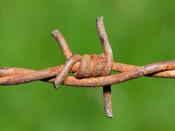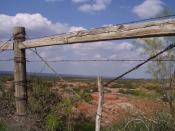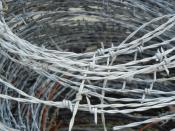In our society, fences can be both a necessity and an obstacle, however, in Leslie Marmon Silko's Ceremony, most fences represent evil. From the barbed-wire fences on a reservation to the high electric fences surrounding the nuclear testing facility, they symbolize many evils. Silko uses many fences to represent the different evils created by witchery: white people, evils that hinder Tayo on his spiritual journey, and the evils facing the Native American people.
In Ceremony, Tayo comes across many different types of fences that symbolize several different things. The first type of fence is a barbed-wire fence that the Indians use to keep their cattle from wandering away and to separate their reservation land from that of their neighbors. The first example is when Tayo sees that some of Joisah's cattle had broken through a fence. "There were tufts of hair snagged in the barbs of wire, and in some places a strand of wire and been pulled loose from a fence pole and was hanging slack like old clothesline (Ceremony, Silko, 1977, 79)."�
In most cases, cattle would cross a fence only because they are pressured in some way. "But they still ran if the men on horseback tried to get close; and if they were pushed into a corner where fences intersected, they lunged through the wire without hesitation (Pg. 79-80)."� This type of fence is a relatively harmless kind as it represents a lesser evil while other fences can represent an even greater evil.
In the story, white people built large fences to keep out unwanted Indians and Mexicans. These fences symbolize two things: the separation between whites and non-whites, and a lie that whites are to blame for all evils. "The people knew what the fence was for: a thousand dollars a mile to...


